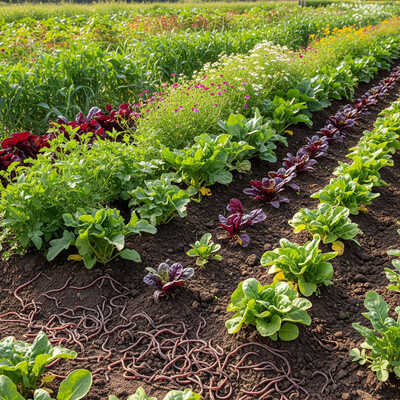23:30 Guide to Ecological Farming: Preserve Soil & Earn More | |
|
Guide to Ecological Farming: How to Preserve the Soil and Earn MoreFor generations, farming has been about coaxing food from the earth. But the modern agricultural landscape is shifting. We've learned that pushing the land to its limits with heavy chemicals and disruptive practices eventually leads to diminishing returns – not just for the environment, but for the farmer's pocketbook too. The good news? A growing movement, often called ecological farming, offers a powerful alternative: a way to cultivate abundance, build healthier ecosystems, and actually increase your profitability in the long run. Ecological farming isn't just a buzzword; it's a holistic approach to agriculture that prioritizes the health of the entire farm ecosystem, starting with the soil. It's about working with natural processes rather than against them, harnessing biodiversity, and minimizing external inputs. For many, the idea of "going green" in farming sounds expensive or less productive. But as we'll explore, the practices central to ecological farming – those focused on preserving your soil – are often the very same practices that lead to reduced costs, more resilient crops, and access to premium markets, directly helping you earn more. This guide will break down the core principles of ecological farming, showing you how each method contributes to robust soil health. More importantly, we'll connect those dots directly to your farm's financial success, demonstrating that responsible stewardship isn't just good for the planet; it's smart business. What is Ecological Farming? A Foundation for Soil and ProfitAt its heart, ecological farming is about understanding and respecting the natural cycles of your farm. It's an umbrella term that includes principles found in organic farming, regenerative agriculture, permaculture, and biodynamic farming. It's not a rigid set of rules, but rather a philosophy centered on:
The beauty of these principles is that they create a virtuous cycle. Healthier soil leads to healthier plants. Healthier plants are more resilient, more productive, and less reliant on costly external inputs. This, in turn, directly impacts your farm's profitability. Pillars of Ecological Farming for Ultimate Soil PreservationYour soil is your most valuable asset. Treating it as such is the cornerstone of both ecological success and increased earnings. Here are the core methods that prioritize soil health: 1. Minimizing Soil Disturbance: The No-Till/Reduced Tillage RevolutionTraditional farming often relies on frequent tillage – plowing and cultivating to prepare seedbeds and control weeds. While it has its immediate benefits, extensive tillage can be incredibly destructive to soil health in the long run. Ecological farming emphasizes minimizing this disturbance. How it Preserves Soil:
How This Helps You Earn More:
2. Maximizing Soil Cover: The Living Blanket for Your FieldsLeaving soil bare for extended periods is an open invitation for erosion, weed growth, and nutrient loss. Ecological farming aims to keep the soil covered as much as possible, mimicking natural ecosystems. How it Preserves Soil:
How This Helps You Earn More:
3. Increasing Crop Diversity: The Strength of VarietyMonoculture – growing a single crop over vast areas – is common in conventional farming but creates vulnerabilities. Ecological farming embraces biodiversity through diverse crop rotations, intercropping (growing two or more crops together), and companion planting. How it Preserves Soil:
How This Helps You Earn More:
4. Integrating Livestock (Where Applicable): The Power of Natural CyclesIf your farm system allows, incorporating livestock can be a transformative ecological practice, acting as natural fertilizers, weeders, and even pest controllers. How it Preserves Soil:
How This Helps You Earn More:
5. Minimizing Synthetic Inputs: The Path to Purity and ProfitA hallmark of ecological farming is the reduced reliance on synthetic fertilizers, pesticides, and herbicides. While these tools have their place in conventional systems, their overuse can harm soil biology, pollute waterways, and carry significant costs. How it Preserves Soil:
How This Helps You Earn More:
How Ecological Farming Directly Helps You Earn MoreBeyond the individual savings and benefits of each practice, ecological farming creates a synergistic effect that boosts your overall farm profitability in several key ways:
Transitioning to Ecological Farming: A Journey, Not a SprintEmbracing ecological farming is a process, not an overnight switch. It requires a shift in mindset, patience, and a willingness to learn and adapt.
ConclusionThe future of farming is undeniably ecological. It's a powerful approach that doesn't just promise environmental benefits but delivers tangible financial returns. By prioritizing the health of your soil through practices like minimizing disturbance, maximizing cover, increasing diversity, integrating livestock, and reducing synthetic inputs, you create a more resilient, productive, and ultimately profitable farm. It requires dedication, a willingness to learn, and a long-term perspective. But the rewards – healthier land, more vibrant crops, reduced expenses, access to premium markets, and a more stable income – make the journey towards ecological farming an incredibly worthwhile investment. Embrace these principles, and you'll not only preserve the soil for future generations but also cultivate a stronger, more prosperous future for your own farm. | |
|
| |
| Total comments: 0 | |
